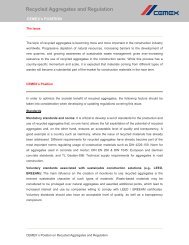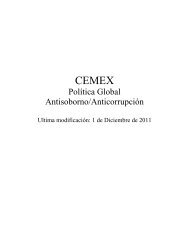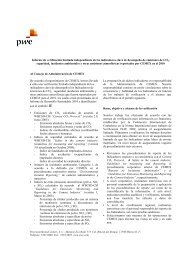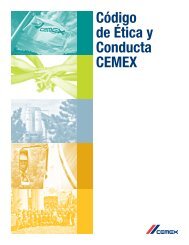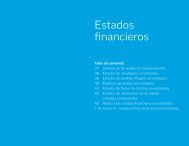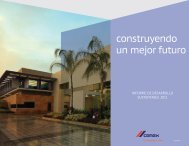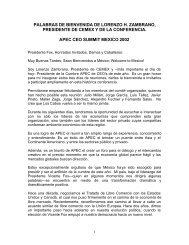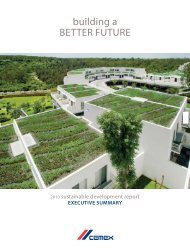building a STRONGER foundation - Cemex
building a STRONGER foundation - Cemex
building a STRONGER foundation - Cemex
Create successful ePaper yourself
Turn your PDF publications into a flip-book with our unique Google optimized e-Paper software.
Aggregates. Our aggregates operations represented approximately 3% of net sales for our operations in Mexico before<br />
eliminations resulting from consolidation in 2010.<br />
Exports. Our operations in Mexico export a portion of their cement production, mainly in the form of cement and to a lesser<br />
extent in the form of clinker. Exports of cement and clinker by our operations in Mexico represented approximately 3% of our total<br />
cement sales volume in Mexico for 2010. In 2010, approximately 18% of our cement and clinker exports from Mexico were to the<br />
United States, 68% to Central America and the Caribbean and 14% to South America.<br />
The cement and clinker exports by our operations in Mexico to the U.S. are marketed through subsidiaries of CEMEX Corp., the<br />
holding company of CEMEX, Inc. All transactions between CEMEX and the subsidiaries of CEMEX Corp., which act as our U.S.<br />
importers, are conducted on an arm’s-length basis.<br />
Our exports of Mexican gray cement from Mexico to the United States were subject to an anti-dumping order that was imposed<br />
by the Commerce Department on August 30, 1990. In March 2006, the Mexican and U.S. governments entered into an agreement to<br />
eliminate U.S. anti-dumping duties on Mexican cement imports following a three-year transition period beginning in 2006. In 2006,<br />
2007 and 2008, Mexican cement imports into the U.S. were subject to volume limitations of 3 million tons, 3.1 million and 3.0 million<br />
tons per year, respectively. Quota allocations to Mexican companies that import cement into the U.S. are made on a regional basis.<br />
The transitional anti-dumping duty during the three-year transition period was lowered to U.S.$3.00 per ton, effective as of April 3,<br />
2006, from the previous amount of approximately U.S.$26.00 per ton. Restrictions imposed by the United States on Mexican cement<br />
imports were eliminated in April 2009. For a more detailed description of the terms of the agreement between the Mexican and U.S.<br />
governments, please see “Item 4 — Information on the Company — Regulatory Matters and Legal Proceedings — Anti-Dumping.”<br />
Production Costs. Our cement plants in Mexico primarily utilize petcoke, but several are designed to switch to fuel oil and<br />
natural gas with minimum downtime. We have entered into two 20-year contracts with PEMEX pursuant to which PEMEX has agreed<br />
to supply us with a total of 1.75 million tons of petcoke per year, including TEG coke consumption, through 2022 and 2023. Petcoke<br />
is petroleum coke, a solid or fixed carbon substance that remains after the distillation of hydrocarbons in petroleum and that may be<br />
used as fuel in the production of cement. The PEMEX petcoke contracts have reduced the volatility of our fuel costs. In addition, since<br />
1992, our operations in Mexico have begun to use alternative fuels, to further reduce the consumption of residual fuel oil and natural<br />
gas. These alternative fuels represented approximately 9% of the total fuel consumption for our operations in Mexico in 2010.<br />
In 1999, we reached an agreement with the TEG consortium for the financing, construction and operation of a 230 megawatt<br />
(“MW”) energy plant in Tamuin, San Luis Potosí, Mexico. We entered into this agreement in order to reduce the volatility of our<br />
energy costs. The total cost of the project was approximately U.S.$360 million. The power plant commenced commercial operations<br />
in April 2004. In February 2007, the original members of the consortium sold their participations in the project to a subsidiary of The<br />
AES Corporation. As part of the original agreement, we committed to supply the energy plant with all fuel necessary for its<br />
operations, a commitment that has been hedged through a 20-year agreement we entered into with PEMEX. These agreements were<br />
reestablished under the same conditions in 2007 with the new operator and the term was extended until 2027. The agreement with<br />
PEMEX, however, was not modified and terminates in 2024. Consequently, for the last 3 years of the agreement, we intend to<br />
purchase the required fuel in the market. For the years ended December 31, 2008, 2009 and 2010, the power plant has supplied<br />
approximately 65%, 74% and 73%, respectively, of our overall electricity needs during such years for our cement plants in Mexico.<br />
In April 2007, we and Acciona formed an alliance to develop a wind farm project for the generation of 250 MW in Juchitan,<br />
Oaxaca, Mexico. We acted as sponsors of the project, which was named EURUS. Acciona provided the required financing,<br />
constructed the facility and currently operates the wind farm. The installation of 167 wind turbines in the farm was finished on<br />
November 15, 2009. The agreements between us and Acciona establish that our cement plants in Mexico should acquire a portion of<br />
the energy generated by the wind farm for a period of at least 20 years, which began in February 2010, when EURUS reached the<br />
committed limit capacity. The power plant had a cost of approximately U.S.$550 million.<br />
We have, from time to time, purchased hedges from third parties to reduce the effect of volatility in energy prices in Mexico.<br />
See “Item 5 — Operating and Financial Review and Prospects — Liquidity and Capital Resources.”<br />
Description of Properties, Plants and Equipment. As of December 31, 2010, we had 15 wholly-owned cement plants located<br />
throughout Mexico, with a total installed capacity of 29.3 million tons per year. We have exclusive access to limestone quarries and<br />
clay reserves near each of our plant sites in Mexico. We estimate that, as of December 31, 2010, the limestone and clay permitted<br />
proven and probable reserves of our operations in Mexico had an average remaining life of approximately 70 and 89 years,<br />
respectively, assuming 2006-2010 average annual cement production levels. As of December 31, 2010, all our production plants in<br />
Mexico utilized the dry process.<br />
As of December 31, 2010, we had a network of 85 land distribution centers in Mexico, which are supplied through a fleet of our<br />
own trucks and rail cars, as well as leased trucks and rail facilities, and operated seven marine terminals. In addition, we had 325<br />
ready-mix concrete plants throughout 79 cities in Mexico, more than 2,600 ready-mix concrete delivery trucks and 16 aggregates<br />
quarries.<br />
43



